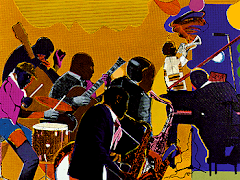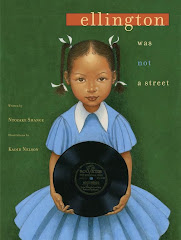

My mother is a teacher and I love going to work with her when I’m off from school. She works with first graders and they are always so adorable. I have encouraged my mom to share with her students information about Gee’s Bend; The Architecture of the Quilt. This exhibition of the most incredibly beautiful and intricate quilts is currently on display at The Philadelphia Museum of Art until December 2008.
My mom’s students are amazing. They know where Gee’s Bend is on a map. They know why women quilted and what materials were used to make quilts. And they can name different quilt patterns-Log Cabin, Crown of Thorns, Flying Geese, Bear Paw, Lone Star, Nine Patch…. These first graders, during a lesson on patterns and shapes, created their own quilt designs and displayed them in the hallway of their school. Not only are other students able to see the first graders’ quilt projects, but there is information displayed on the wall about the Gee’s Bend Exhibition as well.
But, what most inspired me that day was the book my mom read to her class. Each week she reads a book with quilts as its theme. The day I was there, she read Under the Quilt of Night by Deborah Hopkinson. From this book, I , a seventh grader, and the first grade students learned how quilts were used as signals to run-away slaves to convey to them which houses were safe for them to enter and seek refuge on their journey North, to freedom. Some white abolitionists would hang a quilt, over a fence, in front of their house. Run-away slaves had been instructed to look for a certain pattern in the center of a quilt. This particular pattern would indicate to the run-way slaves that this was a house full of kind people, who would give them food and shelter until they moved on to their next destination on the Underground Railroad. How amazing!!!
Again, I urge you to go and visit Gee’s Bend; The Architecture of the Quilt at the Philadelphia Museum of Art.
For more information contact the museum at 215-763-8100 or www.philamuseum.org
My mom’s students are amazing. They know where Gee’s Bend is on a map. They know why women quilted and what materials were used to make quilts. And they can name different quilt patterns-Log Cabin, Crown of Thorns, Flying Geese, Bear Paw, Lone Star, Nine Patch…. These first graders, during a lesson on patterns and shapes, created their own quilt designs and displayed them in the hallway of their school. Not only are other students able to see the first graders’ quilt projects, but there is information displayed on the wall about the Gee’s Bend Exhibition as well.
But, what most inspired me that day was the book my mom read to her class. Each week she reads a book with quilts as its theme. The day I was there, she read Under the Quilt of Night by Deborah Hopkinson. From this book, I , a seventh grader, and the first grade students learned how quilts were used as signals to run-away slaves to convey to them which houses were safe for them to enter and seek refuge on their journey North, to freedom. Some white abolitionists would hang a quilt, over a fence, in front of their house. Run-away slaves had been instructed to look for a certain pattern in the center of a quilt. This particular pattern would indicate to the run-way slaves that this was a house full of kind people, who would give them food and shelter until they moved on to their next destination on the Underground Railroad. How amazing!!!
Again, I urge you to go and visit Gee’s Bend; The Architecture of the Quilt at the Philadelphia Museum of Art.
For more information contact the museum at 215-763-8100 or www.philamuseum.org

























No comments:
Post a Comment